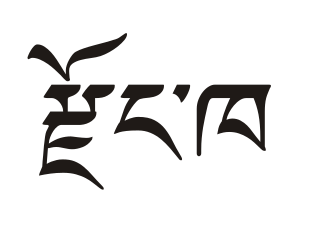Related Research Articles

Sino-Tibetan is a family of more than 400 languages, second only to Indo-European in number of native speakers. Around 1.4 billion people speak a Sino-Tibetan language. The vast majority of these are the 1.3 billion native speakers of Sinitic languages. Other Sino-Tibetan languages with large numbers of speakers include Burmese and the Tibetic languages. Four United Nations member states have a Sino-Tibetan language as their main native language. Other languages of the family are spoken in the Himalayas, the Southeast Asian Massif, and the eastern edge of the Tibetan Plateau. Most of these have small speech communities in remote mountain areas, and as such are poorly documented.

The Tibetic languages form a well-defined group of languages descending from Old Tibetan. According to Nicolas Tournadre, there are 50 Tibetic languages, which branch into more than 200 dialects, which could be grouped into eight dialect continua. These Tibetic languages are spoken in Tibet, the greater Tibetan Plateau, and in the Himalayas in Gilgit-Baltistan, Ladakh, Aksai Chin, Nepal, and in India at Himachal Pradesh, and Uttarakhand. Classical Tibetan is the major literary language, particularly for its use in Tibetan Buddhist scriptures and literature.

Dzongkha is a Tibeto-Burman language that is the official and national language of Bhutan. It is written using the Tibetan script.

Mongar District is one of the 20 dzongkhags (districts) comprising Bhutan. Mongar is the fastest-developing dzongkhag in eastern Bhutan. A regional hospital has been constructed and the region is bustling with many economic activities. Mongar is noted for its lemon grass, a plant that can be used to produce an essential oil. It also has a hydroelectric power-plant on the Kuri Chhu river. Mongar is notable for having the longest work time in all the dzongkhags of Bhutan.
The Kheng people are found primarily in the Zhemgang, Trongsa, Bumthang, Dagana, and Mongar Districts of central Bhutan. They speak the Kheng language, a member of the extended Sino-Tibetan language family belonging to the East Bodish languages group; it is mutually intelligible with the Bumthang language and Kurtöp language to the north. The Kheng people are ethnolinguistically same as the Bumthang people and Kurtöp people of central Bhutan and are more closely related to Ngalop people of western Bhutan than to their neighbors in eastern Bhutan, who are primarily Sharchops and speak Tshangla language. SIL International estimates there are 50,000 Kheng speakers as of 2009.
Tshangla is a Sino-Tibetan language of the Bodish branch closely related to the Tibetic languages. Tshangla is primarily spoken in Eastern Bhutan and acts as a lingua franca in the region; it is also spoken in the adjoining Tawang tract in the Indian state of Arunachal Pradesh and the Pemako region of Tibet. Tshangla is the principal pre-Tibetan language of Bhutan.

Gurung, also known as Tamu Kyi or Tamu Bhāṣā, is a Sino-Tibetan language spoken by the Gurung people of Nepal. The total number of all Gurung speakers in Nepal was 227,918 in 1991 and 325,622 in 2011.

There are two dozen languages of Bhutan, all members of the Tibeto-Burman language family except for Nepali, which is an Indo-Aryan language, and the Bhutanese Sign Language. Dzongkha, the national language, is the only native language of Bhutan with a literary tradition, though Lepcha and Nepali are literary languages in other countries. Other non-Bhutanese minority languages are also spoken along Bhutan's borders and among the primarily Nepali-speaking Lhotshampa community in South and East Bhutan. Chöke is the language of the traditional literature and learning of the Buddhist monastics.
The Khengkha language, or Kheng, is an East Bodish language spoken by ~40,000 native speakers worldwide, in the Zhemgang, Trongsa, and Mongar districts of south–central Bhutan.
The Tibeto-Kanauri languages, also called Bodic, Bodish–Himalayish, and Western Tibeto-Burman, are a proposed intermediate level of classification of the Sino-Tibetan languages, centered on the Tibetic languages and the Kinnauri dialect cluster. The conception of the relationship, or if it is even a valid group, varies between researchers.
The West Himalayish languages, also known as Almora and Kanauric, are a family of Sino-Tibetan languages centered in Himachal Pradesh, Uttarakhand and across the border into Nepal. LaPolla (2003) proposes that the West Himalayish languages may be part of a larger "Rung" group.

The Tamangic languages, TGTM languages, or West Bodish languages or Kaike-Ghale-Tamangic languages (Glottolog), are a family of Sino-Tibetan languages spoken in the Himalayas of Nepal. They are called "West Bodish" by Bradley (1997), from Bod, the native term for Tibet. TGTM stands for Tamang-Gurung-Thakali-Manang.
The East Bodish languages are a small group of non-Tibetic Bodish languages spoken in eastern Bhutan and adjacent areas of Tibet and India. They include:

The Tibeto-Burman languages are the non-Sinitic members of the Sino-Tibetan language family, over 400 of which are spoken throughout the Southeast Asian Massif ("Zomia") as well as parts of East Asia and South Asia. Around 60 million people speak Tibeto-Burman languages. The name derives from the most widely spoken of these languages, Burmese and the Tibetic languages, which also have extensive literary traditions, dating from the 12th and 7th centuries respectively. Most of the other languages are spoken by much smaller communities, and many of them have not been described in detail.
Gongduk or Gongdu is an endangered Sino-Tibetan language spoken by about 1,000 people in a few inaccessible villages located near the Kuri Chhu river in the Gongdue Gewog of Mongar District in eastern Bhutan. The names of the villages are Bala, Dagsa, Damkhar, Pam, Pangthang, and Yangbari (Ethnologue).
Proto-Tibeto-Burman is the reconstructed ancestor of the Tibeto-Burman languages, that is, the Sino-Tibetan languages, except for Chinese. An initial reconstruction was produced by Paul K. Benedict and since refined by James Matisoff. Several other researchers argue that the Tibeto-Burman languages sans Chinese do not constitute a monophyletic group within Sino-Tibetan, and therefore that Proto-Tibeto-Burman was the same language as Proto-Sino-Tibetan.

ʼOle, also called ʼOlekha or Black Mountain Monpa, is a moribund, possibly Sino-Tibetan language spoken natively by 1 person in the Black Mountains of Wangdue Phodrang and Trongsa Districts in western Bhutan. The term ʼOle refers to a clan of speakers.
The Chocha Ngacha language or Chochangachakha or Tsamang is a Southern Tibetic language spoken by about 20,000 people in the Kurichu Valley of Lhuntse and Mongar Districts in eastern Bhutan.

The Bumthang language ; also called "Bhumtam", "Bumtang(kha)", "Bumtanp", "Bumthapkha", and "Kebumtamp") is an East Bodish language spoken by about 20,000 people in Bumthang and surrounding districts of Bhutan. Van Driem (1993) describes Bumthang as the dominant language of central Bhutan.

Mugom-Karmarong is the Sino-Tibetan language variety of the Tibetan people of Mugu district in Nepal. This language variety represents two dialects Mugom and Karmarong, which are spoken by distinct ethnicities and are separate language in the perceptions of these groups. Based on census data taken in 2011, the total population of Mugom-Karmarong is estimated to be about 7,500 speakers.
References
- ↑ Tournadre 2014, p. 105.
- ↑ Shafer 1955, pp. 100–101.
- ↑ Hill 2010, p. 111.
- ↑ Bradley 1997, p. 4.
- ↑ Bradley 1997, pp. 3–15.
- Bradley, David (1997), "Tibeto-Burman languages and classification" (PDF), in Bradley, David (ed.), Tibeto-Burman languages of the Himalayas, Papers in South East Asian linguistics, vol. 14, Canberra: Pacific Linguistics, pp. 1–71, ISBN 978-0-85883-456-9.
- van Driem, George (1994). East Bodish and Proto-Tibeto-Burman morphosyntax. Current Issues in Sino-Tibetan Linguistics, Osaka: The Organizing Committee of the 26th International Conference on Sino-Tibetan Languages and Linguistics.
- van Driem, George (1995). Een eerste grammaticale verkenning van het Bumthang, een taal van midden-Bhutan. Leiden: Onderzoekschool CNWS.
- van Driem, George (2001) Languages of the Himalayas: An Ethnolinguistic Handbook of the Greater Himalayan Region. Brill.
- Hill, Nathan W. (2010), "Overview of Old Tibetan synchronic phonology" (PDF), Transactions of the Philological Society, 108 (2): 110–125, CiteSeerX 10.1.1.694.8283 , doi:10.1111/j.1467-968X.2010.01234.x.
- Hyslop, G., (2008a). Kurtöp phonology in the context of Northeast India. In: Morey, S., Post, M. (Eds.), North East Indian Linguistics 1: Papers from the First International Conference of the North East Indian Linguistic Society. Cambridge University Press, Cambridge, pp. 3–25.
- Hyslop, G., (2008b). "Kurtöp and the classification of the languages of Bhutan." In: Proceedings from the 42nd Annual Meeting of the Chicago Linguistic Society 42, vol. 2, South Asian Linguistics, Case, Voice, and Language Coexistence. University of Chicago Press, Chicago.
- Hyslop, G., (2009), "Kurtöp Tone: A tonogenetic case study." Lingua 119: 827–845
- Lu shao zun 陸紹尊(2002). 門巴語方言研究 Menbayu fangyan yanjiu [Studies in the dialects of the Monpa language.] Beijing: Publishing House of Minority Nationalities.
- Michailovsky, Boyd and Martine Mazaudon (1994). “Preliminary Notes on the Languages of the Bumthang Group (Bhutan).” Tibetan Studies: proceedings of the 6th Seminar of the International Association for Tibetan Studies. Ed. Per Kværne. Vol 2. Oslo: The Institute of Comparative Research in Human Culture. 545-557.
- Shafer, Robert (1955), "Classification of the Sino-Tibetan languages", Word (Journal of the Linguistic Circle of New York), 11 (1): 94–111, doi: 10.1080/00437956.1955.11659552 .
- Tournadre, Nicolas (2014), "The Tibetic languages and their classification", in Owen-Smith, Thomas; Hill, Nathan W. (eds.), Trans-Himalayan Linguistics: Historical and Descriptive Linguistics of the Himalayan Area, De Gruyter, pp. 103–129, ISBN 978-3-11-031074-0. (preprint)
